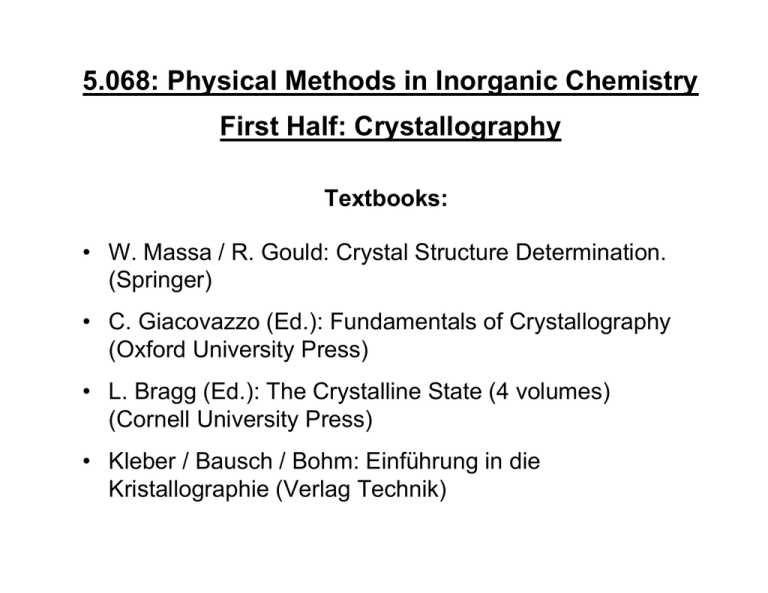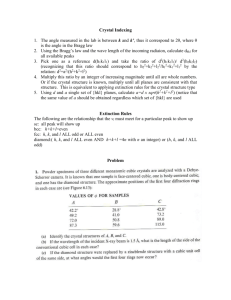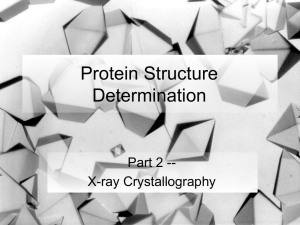5.068: Physical Methods in Inorganic Chemistry First Half: Crystallography
advertisement

5.068: Physical Methods in Inorganic Chemistry First Half: Crystallography Textbooks: • W. Massa / R. Gould: Crystal Structure Determination. (Springer) • C. Giacovazzo (Ed.): Fundamentals of Crystallography (Oxford University Press) • L. Bragg (Ed.): The Crystalline State (4 volumes) (Cornell University Press) • Kleber / Bausch / Bohm: Einführung in die Kristallographie (Verlag Technik) Crystallography: Strengths and Weaknesses Strengths: • Complete 3D structure with almost no assumptions. • No size limitations (M > 107) • Fast Weaknesses: • You need a crystal. • Average over space and time (no dynamics). • Esp. for very large molecules: resolution often rather low. X-Ray Crystallography: The Early Days Wilhelm Conrad Röntgen (1845-1923) 1895: X-Rays (Nobel Prize 1901) Born in Lennep (now Remscheid), Germany. Studied physics at the Polytechnic in Zürich. Prof. for physics in Strassbourg (1876-79), Giessen (1879-88), Würzburg (1888-1900), München (1900-20). Research on elasticity, capillary action, specific heats, heat conduction in crystals, piezoelectricity, etc. 1895, while experimenting with electric current in an evacuated glass tube, he saw fluorescence of barium platinocyanide and figured that rays of some kind must be traveling across the room. More experiments followed. X-rays go through paper, wood, aluminum, they blacken photo plates and do not show properties of light like reflection or refraction. X-ray photographs of his wife’s hand. 1901 first Nobel Prize for physics to W. C. Röntgen. X-Ray Crystallography: The Early Days Max Theodor Felix von Laue (1879-1960) 1912: X-Ray Diffraction (Nobel Prize 1914) Born in Pfaffendorf, Germany. Studied physics in Strassbourg, Göttingen, München and Berlin Prof. for physics in Zürich (1912-14), Frankfurt (1914-16), Würzburg (1916-19), Berlin (1919-43), Director MPI for Physical Chemistry in Berlin (1951-1958). In order to prove that X-rays were actually electromagnetic waves, he wanted to produce some kind of interference. His then more famous colleagues Sommerfeld and Wien thought it would never work, but Walter Friedrich (one of Sommerfeld’s assistants) and Paul Knipping tried it (with CuSO4) and succeeded after a while. Laue worked out the mathematics and the whole thing was published in 1912. 1914 Nobel Prize for physics to M. von Laue. X-Ray Crystallography: The Early Days (William) Lawrence Bragg (1890-1971) 1912: Bragg law (Nobel Prize 1915) Born in Adelaide, Australia. Son of the Englishman William (Henry) Bragg (1862-1942). 1909 he came to Engand with his father and started to study physics at Trinity College in Cambridge. Lecturer at Trinity College, Cambridge (1914-19) and Prof. for physics in Manchester (1919-37), director of the National Physical Laboratory (1937-38), Prof. for experimental physics in Cambridge (1938-53) and Chairman of the Frequency Advisory Committee (1958-60). Inspired by the work of M. von Laue, Lawrence Bragg, a grad student then, came up with nλ = 2d sin Θ . Using the first diffractometer, built by W. H. Bragg to measure the wavelength of X-Rays, the two Braggs determined the crystal structures of NaCl and other compounds. 1915 Nobel Prize for physics to W. L. Bragg (then 25 years old) and W. H. Bragg. Nobel Prizes for X-Ray Crystallography • 1901: N.P. in Physics to Wilhelm Conrad Röntgen. Discovery of X-rays. • 1914: N.P. in Physics to Max Theodor Felix von Laue. X-ray diffraction. • 1915: N.P. in Physics to William Henry Bragg & William Lawrence Bragg. Bragg law and crystal structures. • 1962: N.P. in Chemistry to Max Perutz & John Cowdery Kendrew. Structures of Hemoglobin and Myoglobin (isomorphous replacement). • 1962: N.P. in Medicine to James Dewey Watson, Francis Harry Compton Crick & Maurice Hugh Frederick Wilkins (Rosalind Franklin). Structure of DNA from fiber diffraction. • 1964: N.P. in Chemistry to Dorothy Crowfoot Hodgkin. Crystal structure of vitamin B12. • 1976: N.P. in Chemistry to William Nunn Lipscomb Jr. Structures and bonding conditions of Boranes. • 1985: N.P. in Chemistry to Herbert Aaron Hauptman & Jerome Karle (Isabella Karle). Direct Methods. • 1988: N.P in Chemistry to Johann Deisenhofer, Robert Huber & Hartmut Michel. Structure of bacteriorhodopsin (a photosynthetic reaction center). A Line of Descent in X-Ray Crystallography Wilhelm Bragg (dad) Lawrence Bragg (son) NaCl, KCl (1912) Lalor Burdick Chalcopyrite (1916) John Bernal tobacco mosaic virus (1953-58) Max Perutz & John Kendrew Hemoglobin & myoglobin (1938-60) Dorothy Hodgkin Vitamin B12 (1956) Rosalind Franklin, Francis Crick & James Watson George Sheldrick Structure of DNA, (1953) Roscoe Dickinson Hexamethylenetetramine (1923) Linus Pauling Secondary structure of proteins, (1951) SHELX, direct methods Richard Dickerson & Dough Rees DNA/RNA structures Membrane proteins David Eisenberg & Todd Yeates Peter Müller Your Name Here 3D domain swapping Twinning, symmetry MIT OpenCourseWare http://ocw.mit.edu 5.069 Crystal Structure Analysis Spring 2008 For information about citing these materials or our Terms of Use, visit: http://ocw.mit.edu/terms.






